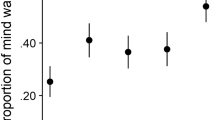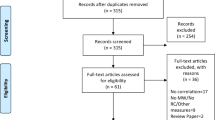Abstract
In many situations, increasing task difficulty decreases thoughts that are unrelated to the task (i.e., mind-wandering). In the context of reading, however, recent research demonstrated that increasing passage reading difficulty actually increases mind-wandering rates (e.g., Feng et al. in Psychon Bull Rev 20:586–592, 2013). The primary goal of this research was to elucidate the mechanism that drives this positive relation. Across Experiments 1–3, we found evidence that the effect of Flesch–Kincaid reading difficulty on mind-wandering is partially driven by hard passages having longer sections of text (i.e., more words per screen) than easy passages when passages are presented one sentence at a time. In Experiment 4, we controlled for reading difficulty, and found that section length was positively associated with mind-wandering rates. We conclude by proposing that individuals may tend to disengage their attention from passages with relatively long sections of text because they appear to be more demanding than passages with shorter sections (even though objective task demands are equivalent).
Similar content being viewed by others
Notes
Including participants who completed fewer than six passages did not affect the significance of any results (here, or in subsequent experiments).
Raftery’s labeling system for various levels of pBIC is as follows: “weak” (.50–.75), “positive” (.75–.95), “strong” (.95–.99), “very strong” (> .99).
Twenty-six participants had 14 easy and 16 hard thought probes, nineteen participants had 15 easy and 15 hard thought probes, fifty-six participants had 15 easy and 16 hard thought probes, thirty-two participants had 16 easy and 15 hard thought probes, and twenty-two participants had 16 easy and 16 hard thought probes. In total, then, forty-one participants had an equal number of thought probes for easy and hard passages (i.e., either 15-15 or 16-16).
In the sentence presentation condition, participants could “outpace” a thought probe’s timed appearance if they read the passages very rapidly. This was an uncommon occurrence: participants missed, on average, 1.5% of thought probes.
On average, participants missed 2.8% of thought probes due to rapid reading.
On average, participants missed 2.8% of thought probes due to rapid reading.
References
Antrobus, J. S., Singer, J. L., & Greenberg, S. (1966). Studies in the stream of consciousness: experimental enhancement and suppression of spontaneous cognitive processes. Perceptual and Motor Skills, 23, 399–417.
Bjork, R. A. (1994). Institutional impediments to effective training. In D. Druckman & R. A. Bjork (Eds.), Learning, remembering, believing: Enhancing human performance (pp. 295–306). Washington, DC: National Academy Press.
Dixon, P., & Bortolussi, M. (2013). Construction, integration, and mind wandering in reading. Canadian Journal of Experimental Psychology, 67, 1–10.
Erdfelder, E., Faul, F., & Buchner, A. (1996). GPOWER: A general power analysis program. Behavior Research Methods, Instruments, & Computers, 28, 1–11.
Feng, S., D’Mello, S., & Graesser, A. C. (2013). Mind wandering while reading easy and difficult texts. Psychonomic Bulletin & Review, 20, 586–592.
Filler, M. S., & Giambra, L. M. (1973). Daydreaming as a function of cueing and task difficulty. Perceptual and Motor Skills, 37, 503–509.
Forrin, N. D., Risko, E. F., & Smilek, D. (2017). In the eye of the beholder: Evaluative context modulates mind-wandering. Manuscript under review.
Forster, S., & Lavie, N. (2009). Harnessing the wandering mind: The role of perceptual load. Cognition, 111, 345–355.
Giambra, L., & Grodsky, A. (1989). Task unrelated images and thoughts whilst reading. In J. Shorr, P. Robin, J. A. Connek, & M. Wolpin (Eds.), Imagery: Current perspectives. New York: Plenum Press.
Klare, G. R. (1974). Assessing readability. Reading Research Quarterly, 10, 62–102.
Krawietz, S. A., Tamplin, A. K., & Radvansky, G. A. (2012). Aging and mind wandering during text comprehension. Psychology and Aging, 27, 951–958.
Kurzban, R., Duckworth, A., Kable, J. W., & Myers, J. (2013). An opportunity cost model of subjective effort and task performance. Behavioral and Brain Sciences, 36, 661–679.
Masson, M. E. J. (2011). A tutorial on a practical Bayesian alternative to null-hypothesis significance testing. Behavior Research Methods, 43, 679–690.
McKiernan, K. A., D’Angelo, B. R., Kaufman, J. N., & Binder, J. R. (2006). Interrupting the “stream of consciousness”: An fMRI investigation. Neuroimage, 29, 1185–1191.
Mills, C., D’Mello, S. K., & Kopp, K. (2015). The influence of consequence value and text difficulty on affect, attention, and learning while reading instructional texts. Learning and Instruction, 40, 9–20.
Mills, C., D’Mello, S., Lehman, B., Bosch, N., Strain, A., & Graesser, A. C. (2013). What makes learning fun? Exploring the influence of choice and difficulty on mind wandering and engagement during learning. In C. H. Lane, K. Yacef, J. Mostow, & P. Pavlik (Eds.), Artificial intelligence in education (pp. 71–80). Berlin: Springer.
Raftery, A. E. (1995). Bayesian model selection in social research. In P. V. Marsden (Ed.), Sociological methodology 1995 (pp. 111–196). Cambridge, MA: Blackwell.
Smallwood, J., Fishman, D. J., & Schooler, J. W. (2007a). Counting the cost of an absent mind: Mind wandering as an underrecognized influence on educational performance. Psychonomic Bulletin & Review, 14, 230–236.
Smallwood, J., McSpadden, M., & Schooler, J. W. (2007b). The lights are on but no one’s home: Meta-awareness and the decoupling of attention when the mind wanders. Psychonomic Bulletin & Review, 14, 527–533.
Smallwood, J., Nind, L., & O’Connor, R. C. (2009). When is your head at? An exploration of the factors associated with the temporal focus of the wandering mind. Consciousness and Cognition, 18, 118–125.
Smallwood, J., & Schooler, J. W. (2006). The restless mind. Psychological Bulletin, 132, 946–958.
Teasdale, J. D., Proctor, L., Lloyd, C. A., & Baddeley, A. D. (1993). Working memory and stimulus-independent thought: Effects of memory load and presentation rate. European Journal of Cognitive Psychology, 5, 417–433.
Thomson, D. R., Besner, D., & Smilek, D. (2013). In pursuit of off-task thought: Mind wandering-performance trade-offs while reading aloud and color naming. Frontiers in Psychology, 4, 360.
Unsworth, N., & McMillan, B. D. (2013). Mind wandering and reading comprehension: Examining the roles of working memory capacity, interest, motivation, and topic experience. Journal of Experimental Psychology. Learning, Memory, and Cognition, 39, 832–842.
Xu, J., & Metcalfe, J. (2016). Studying in the region of proximal learning reduces mind wandering. Memory & Cognition, 44, 681–695.
Zwaan, R. A., Langston, M. C., & Graesser, A. C. (1995). The construction of situation models in narrative comprehension: An event-indexing model. Psychological Science, 6, 292–297.
Acknowledgements
We thank Safa Bajwa, Zeynep Ermis, Grace Lin, Tasha McFarland, Amanda Nova, Mona Qutub, Brandon Stolz, Jane Szeto, and Julian Wang for their help in collecting data.
Funding
This research was supported by Natural Sciences and Engineering Research Council of Canada Discovery Grant (RGPIN-2014-06459) awarded to Daniel Smilek.
Author information
Authors and Affiliations
Corresponding author
Ethics declarations
Conflict of interest
The authors declare that they have no conflict of interest.
Ethical approval
All procedures performed in studies involving human participants were in accordance with the ethical standards of the institutional and/or national research committee and with the 1964 Helsinki declaration and its later amendments or comparable ethical standards.
Informed consent
Informed consent was obtained from all individual participants included in the study.
Electronic supplementary material
Below is the link to the electronic supplementary material.
Appendix: Passage reading time analyses
Appendix: Passage reading time analyses
Experiment 1a
Reading times before the first thought probe were not recorded for each participant due to a programming error. After the first probe, reading times for Flesch–Kincaid easy passages (M = 134.69 s, SD = 49.40 s) and Flesch–Kincaid hard passages (M = 134.40 s, SD = 50.78), were nonsignificantly different, t(162) = 0.18, p = .86. Given that the first probe appeared at a random 10–30 s time for each participant in this large sample, the mean passage reading time would have been approximately 20 s longer in each condition.
Experiment 1b
Reading times (not including response times to thought probes) were significantly longer for easy passages (M = 166.47 s, SD = 56.81 s) than for hard passages (M = 157.48, SD = 62.31), t(154) = 3.07, p = .002, d = 0.15. This result may have reflected the fact that the easy passages had more sentences than the hard passages and, therefore, participants had to press the spacebar to advance sentences more often for the easy passages. Another possible explanation is that participants may have been more likely to skim read the hard passages because they perceived them as less interesting than the easy passages (see Table 2).
Experiment 2
In the sentence presentation condition, reading times were significantly longer for easy passages (M = 182.86 s, SD = 56.02 s) than for hard passages (M = 173.14, SD = 60.52), t(97) = 2.69, p = .01, d = 0.17. In the page presentation condition, reading times before the first thought probe were not recorded due to a programming error. After the first probe, reading times across easy passages (M = 147.93 s, SD = 52.36 s) and hard passages (M = 145.60, SD = 54.67), were nonsignificantly different, t(98) = 0.92, p = .36.
Experiment 3
Reading times for easy passages (M = 165.54 s, SD = 48.62 s) and hard passages (M = 165.81, SD = 48.71), were nonsignificantly different, t(98) = 0.11, p = .91. Overall, reading time data from Experiments 1–3 suggest that Flesch–Kincaid reading difficulty did not significantly influence passage reading times when the length of sections of text in which a passage is presented is controlled.
Experiment 4a
Consistent with the reading time results of the prior experiments, reading times were significantly longer for passages with short sections (M = 171.03 s, SD = 59.75 s) than for passages with moderate-length sections (M = 160.17, SD = 65.67), t(49) = 3.09, p = .003, d = 0.17. This difference in reading times may have arose simply because participants with short sections also had more sections than passages with moderate-length sections, and, therefore, participants had to press the spacebar to advance sections more frequently for the short-section passages. Another possibility is that participants were more likely to skim-read the moderate-section passages because they tended to perceive them as less interesting than the short-section passages (see Table 4).
Experiment 4b
A repeated measures ANOVA revealed a significant difference in reading times between passages that were presented across short (M = 179.12 s, SD = 55.85 s), moderate (M = 175.30 s, SD = 65.60 s), and long (M = 162.85 s, SD = 59.75 s) sections, F(1, 81.01) = 4.47, MSE = 1102.62, p = .02, η2 = 0.08 (with a Greenhouse–Geisser correction). Only the difference between short-section passages and long-section passages was significant, t(52) = 2.32, p = .02, d = 0.25.
Rights and permissions
About this article
Cite this article
Forrin, N.D., Risko, E.F. & Smilek, D. On the relation between reading difficulty and mind-wandering: a section-length account. Psychological Research 83, 485–497 (2019). https://doi.org/10.1007/s00426-017-0936-9
Received:
Accepted:
Published:
Issue Date:
DOI: https://doi.org/10.1007/s00426-017-0936-9




